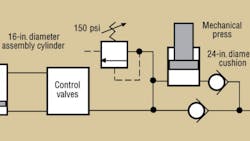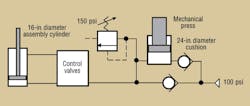The Old Timer Part 11: Mechanical Press Raises Air Pressure
The Old Timer of Royal Oak, Mich., was a regular contributor to H&P years before we ever even heard of the internet. But most of his advice is just as ueful — and interesting — today.
So rather than leave his wisdom printed on pages archived in our storage room, I pulled out issues from the late 1980s and early 1990s and have been reproducing relevant entries in this blog. Here is my eleventh entry, which was originally published in the October 1988 issue:
Mechanical press raises air pressure
We first checked all the components in the pneumatic circuit to make sure they could handle higher pressure. We found that all were rated for 150 psi or greater so that was no problem. Then we considered adding auxiliary air or hydraulic jacks to the station but the machine’s base design wouldn’t allow us to work them in. Next we thought about a higher-pressure auxiliary compressor just for this machine but a big potential union problem on set-up and maintenance made us discard that idea.
Then we learned that a small, high-speed draw press with a 24.-in die cushion was being taken out of service in another department. The press had a 300-psi rating. Could we use it somehow?
As it turned out, we could. We plumbed the die cushion in parallel with the shop air supply to the production machine and connected a 150-psi relief valve and a couple of check valves. We next wired the electric circuit so that when the operator fired the air control valves, he tripped the mechanical press, too. The die cushion acted like a booster and gave us all the 130-psi air we needed. The time required to cycle the press was no problem because the new larger assemblies took more time at the other machine stations.
It looked a little crazy to see a mechanical press running next to an assembly line — doing nothing but displacing its cushion, but it worked like a charm for us. We eventually added a limit switch on the press to release its cylinder only after air was recovered in the cushion — making our operation very efficient, with little or no compression temperature rise.
About the Author
Alan Hitchcox Blog
Editor in Chief
Alan joined Hydraulics & Pneumatics in 1987 with experience as a technical magazine editor and in industrial sales. He graduated with a BS in engineering technology from Franklin University and has also worked as a mechanic and service coordinator. He has taken technical courses in fluid power and electronic and digital control at the Milwaukee School of Engineering and the University of Wisconsin and has served on numerous industry committees.

Leaders relevant to this article:

